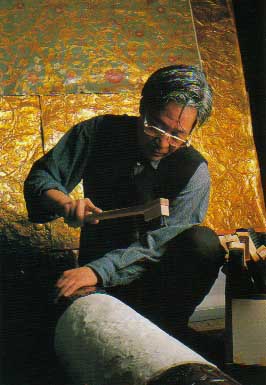Kinkarakami Institute | Custom Production
Available![]()
Please Contact us freely for any inquiries or estimates.
Location: 4-1-20 mejiro toshima-ku , Tokyo
@03-3565-0169
Peason in chage : Mai Ebata@kinkarakami@gmail.com
Instagram:@https://www.instagram.com/kinkarakami?igsh=MXM3MnJpcnI4eXl5dQ==
| What
is Kinkarakami? In the Meiji era, Kinkarakami gained international acclaim and was widely exported. Historic examples of Japanese-made Kinkarakami can still be seen in the Het Loo Palace in the Netherlands and Moritzburg Castle in Germany. However, the craft faded into obscurity by the early 20th century. Thanks to the restoration project of the Otaru Branch of Nippon Yusen, artisan Takashi Ueda, founder of the Kinkarakami Institute, revived this lost art.
|
| History in the Restoration of Kinkarakami | |
| 1987 | Otaru Branch of Nippon Yusen |
| 1990 | Tokyo Metropolitan Theatre |
| 1994 | Former Hayashi Residence (now Okaya Silk Museum) |
| 1995 | Kure Irifuneyama Memorial Hall |
| 2000 | Kobe Ijinkan (Ijokaku) |
| 2003 | Former Iwasaki Residence, Tokyo |
| 2018 | Former Maeda Residence, Tokyo |
| 2024 | 2nd phase of restoration at Otaru Branch of Nippon Yusen |
| Exhibition History and event of the Kinkarakami Institute | |
| 1990 | Solo Exhibition "Revived Kinkarakami" (Tokyo, Kyoto, Nagoya) |
| 2005 | "Kinkarakami in Western-Style Houses"
(Paper Museum); "Meiji Era Western Architecture Decorated with Kinkarakami"
(Shizuoka) |
| 2006 | Dancing Patternsh (Lalique Museum, Hakone) |
| 2007 | Featured in NHKfs "Museum of Dreams:
100 Masterpieces of World Crafts" |
| 2010 | Solo Exhibition gRomantic World of Kinkarakamih
(Tokyo Metropolitan Theatre) |
| 2011 | gRomantic World of Kinkarakami IIh (Kyoto Tokyu
Hotel, Gallery Kazahana) |
| Romantic
World of Kinkarakami IIIh (Fukuoka); gThe World of Kinkarakami ? Classical
to Contemporaryh (Mikimoto Hall); Featured in gGlass Brilliance ? Rene
Lalique and Kinkarakami Collaborationh (Matsunaga Memorial Museum) |
|
| 2014 | Kinkarakami Exhibition Works by Takashi
Ueda" (Paper Museum) |
| 2020 | Kinkarakarakami Washi Wallpaper of the
Modern Erah (Paper Museum) |
| 2023 | The Inherited Beauty
of Japanh (Carre Moji Gallery) |
| 2024 | gEdo-Tokyo Rethink Exhibitionh (Former
Iwasaki Residence) |
| About the Kinkarakami Institute | |
|
1985 Founded in 1985
by Takashi Ueda in Mejiro, Tokyo.
|
|
| Founder Profile Takashi Ueda | |
 |
Born in 1934 in Kyoto. Founded Kinkarakami Institute in 1985. Designated as a Preserver of Important Cultural Techniques by the Japanese government in 2005. Awarded order of Emperor in 2012. past way on Aprill 20 in 2050
|
| Mai Ebata (granddaughter of Ueda) |
|
Born in Kyoto Graduated in 2014 from Kyoto Saga University of Arts, majoring in Japanese Painting. In 2015, moved to Tokyo and
began working under Takashi Ueda at the Kinkarakami Institute, where
she studied the production of kinkarakami and the restoration techniques
of kinkarakawashi (gilded leather paper).She was involved in the restoration,
reproduction, and creation of kinkarakami for the following historical
buildings: Reception Room of the Former
Iwasaki House Garden (Taito-ku, Tokyo)
|
| à§ìHö | ãc®i¤¦¾½©µjÉ墀 | डãÌæègÝ |